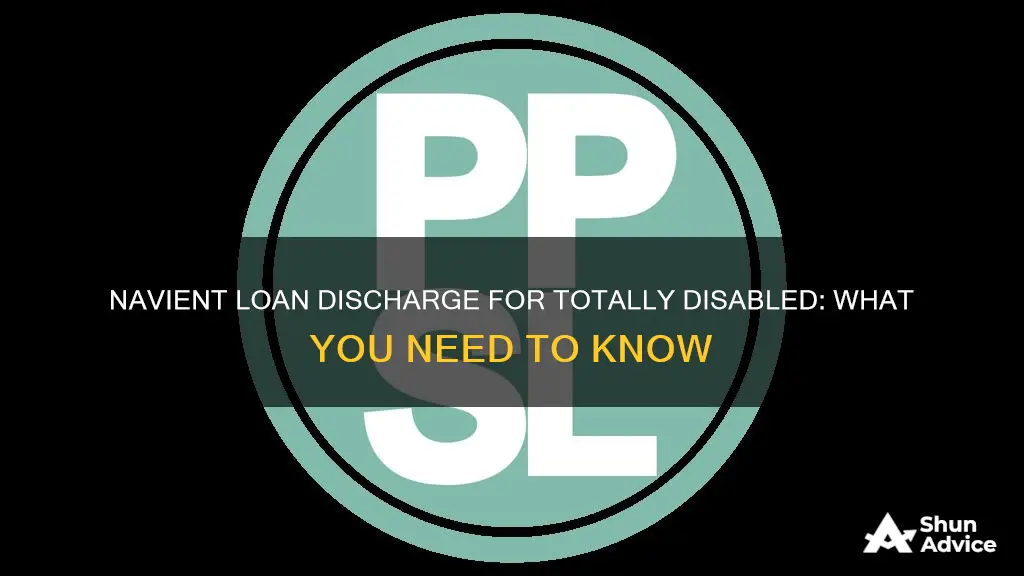
Navient, a student loan servicer, offers a Total and Permanent Disability discharge for borrowers with federal student loans or TEACH Grant service obligations. This means that if you are totally and permanently disabled, you may qualify for a discharge of your federal student loans, and you will no longer be required to repay them. However, it is important to note that Navient private student loans are not eligible for TPD elimination. For private loans, borrowers must refer to their loan agreements to determine if there is an equivalent discharge option. Additionally, there are other benefits available to members of the armed forces, such as the SCRA interest-rate cap, which limits interest on student loans obtained prior to active duty military service to 6%.
| Characteristics | Values |
|---|---|
| Type of loans eligible for discharge | Federal student loans, TEACH Grant service obligation, and certain private student loans |
| Requirements for discharge | Documentation from the Veteran's Administration (VA) showing one or more service-connected disabilities that are 100% disabling, or a determination of total disability based on individual unemployability |
| Application process | Complete the Education Department's total and permanent disability discharge application, attach supporting documentation, and send to Nelnet for processing |
| Additional information | A three-year monitoring period may apply after the loan is discharged; interest rates are capped at 6% for loans obtained prior to active-duty military service |
What You'll Learn

Federal student loans and TPD discharge
If you have a total and permanent disability (TPD), you may be eligible for a discharge of your federal student loans. TPD discharge means that you won't have to repay your federal student loans or complete any TEACH Grant service obligations. As of May 2023, approximately 492,000 borrowers have received loan forgiveness through TPD discharge.
To qualify for a TPD discharge, you must meet certain criteria. Firstly, you must demonstrate that your disability, whether physical or mental, severely limits your ability to work, both currently and in the future. You can do this by providing specific types of proof of your disability. One way to qualify is if the VA has awarded you a disability determination due to a service-connected disability that is 100% disabling or if you are deemed totally disabled based on an individual unemployability rating. Additionally, if you are eligible for Social Security Disability Insurance (SSDI) or Supplemental Security Income (SSI) benefits, you may also qualify for TPD discharge. However, receiving SSDI or SSI benefits does not automatically guarantee TPD discharge.
If you believe you have a qualifying VA disability determination or meet the criteria for SSDI or SSI benefits, you can submit a TPD discharge application. You will need to provide documentation showing when the VA awarded you the disability determination or proof of your eligibility for SSDI or SSI benefits. It's important to note that only certain types of medical professionals can certify your disability for TPD discharge, and they must be licensed to practice in the United States.
For more detailed information about TPD discharge, including eligibility requirements, applications, and frequently asked questions, you can visit the official TPD discharge website, DisabilityDischarge.com.
Annuitant Spouse Consent: New York Law Explained
You may want to see also

Private student loans and TPD discharge
Total and Permanent Disability (TPD) discharge is a form of loan forgiveness for those with federal student loans. As of May 2023, around 492,000 borrowers have had their loans forgiven through TPD discharge. To qualify for TPD discharge, an individual must have a disability that severely limits their ability to work, now and in the future. This can be either a physical or mental disability.
For those with private student loans, TPD discharge is not applicable. However, some private loan providers, such as Navient, offer TPD discharge for certain private student loans. It is important to carefully review your private loan agreement to understand if TPD discharge is an option for you. If you have private loans with Navient, you may need to reach out to their Office of the Customer Advocate for more information.
There are multiple ways to qualify for TPD discharge. One way is to receive a disability determination from the VA. If you are a veteran with a service-connected disability that is 100% disabling, or if you are totally disabled based on an individual unemployability rating, you may qualify for TPD discharge. The VA and the SSA work together to identify individuals who qualify, and they will send you a letter if you are eligible. If you believe you qualify and have not received a letter, you can submit a TPD discharge application.
Another way to qualify for TPD discharge is to apply for Social Security Disability Insurance (SSDI) or Supplemental Security Income (SSI) benefits. To qualify for TPD discharge through this method, your next continuing disability review must be scheduled within five to seven years from the date of your last SSA disability determination, or you must have a medical onset date for SSDI or SSI of at least five years before you apply for TPD discharge. Additionally, you can qualify for TPD discharge by having a certified medical professional certify Section 4 of your TPD application. It is important to note that not just any medical professional can certify your disability; it must be a specific type of licensed medical professional.
How Bonuses Affect Loan Eligibility and Income Assessment
You may want to see also

Military benefits and active duty
Military service comes with a range of benefits, both financial and personal. Active-duty military personnel received a 5.2% pay raise in 2024, in addition to other financial benefits such as paid leave days, retired-pay plans, free or reduced-cost housing, and special incentive pay. The military also offers free financial and tax consultations.
One of the notable benefits of military service is the comprehensive medical insurance program, TRICARE Prime, which provides full coverage at no cost to active-duty service members for any type of care within its network. TRICARE also offers several plans that cover service members and their immediate family members at competitive rates.
In addition to financial benefits, a military career offers unique opportunities for personal development and growth. Military service can help individuals develop both professionally and personally, offering tuition assistance, leadership development, and travel opportunities.
It's important to note that Navient does offer a Total and Permanent Disability (TPD) discharge for certain private student loans. However, this discharge only applies to federal loans, and for private loans, individuals would need to refer to their loan agreement to determine if there is an equivalent discharge option.
Multiple Buyers: Boon or Bane for Loans?
You may want to see also

SCRA interest-rate cap
Navient's website states that if you have a Total and Permanent Disability (TPD), you may qualify for a TPD discharge of certain private student loans. However, it is important to note that TPD discharge is only for federal loans. If you have private loans with Navient, you will need to check your loan agreement to see if they offer an equivalent discharge option.
Now, for the SCRA interest-rate cap:
The Servicemembers Civil Relief Act (SCRA) provides legal and financial protections for active-duty service members and their families in the military. One of the key protections offered by the SCRA is the 6% interest rate cap on certain loans taken out before or during active-duty service. This cap applies to auto loans, mortgages, credit cards, other installment loans, and student loans taken out after August 14, 2008. It is important to note that this interest rate cap only applies to certain consumer loans offered to active-duty service members and their dependents and does not include all types of loans.
To qualify for the 6% interest rate cap, you must notify your lender in writing and provide a copy of your military orders calling you to active duty. You can request an interest rate reduction from your lender at any time while serving on active duty and up to 180 days after being released. The lender must then reduce your interest rate to 6% for the duration of your active duty service, and any interest above 6% is forgiven. This means that the lender cannot add the amount of interest above 6% back into the loan after you complete your active duty service.
For Reservists called to active duty, the interest rate reduction will begin on the date they receive their orders. Lenders are generally required to refund any amounts charged above the 6% cap during the active-duty service period. For mortgages, the interest rate reduction lasts for one year after the last day of active-duty service. It is important to note that creditors can challenge this provision if they believe your ability to pay a rate higher than 6% is not materially affected by your military service.
Additionally, it is possible to waive your rights under the SCRA, but only written waivers signed during or after a service member's period of military service are effective. It is always recommended to seek the advice of a qualified attorney before signing any waiver document.
Tesco Loans: PPI Coverage and Your Rights
You may want to see also

Cosigner release
Navient offers a range of benefits and services for members of the armed forces, including the option to apply for a Total and Permanent Disability (TPD) discharge of federal student loans. If you are totally and permanently disabled, you may be eligible for a TPD discharge, which means you will no longer be required to repay your federal student loans.
However, in the case of private student loans, it is a different story. Navient has been known to deny cosigner release even when the loan qualifies for TPD discharge. In one case, a borrower with a private student loan from Navient since 2004, who had a cosigner on the loan, was approved for TPD discharge. Navient sent a letter indicating that they would remove the borrower from the loan and transfer the responsibility to the cosigner. This contradicts the initial statement made by Navient representatives, who said that if the borrower was approved for TPD discharge, the loan would be discharged, and no one would owe anything.
The issue of private student loan cosigner release is a technical one. Navient has certain requirements that must be met before they will consider a request for cosigner release, including a satisfactory history of making 12 consecutive principal and interest payments immediately preceding the cosigner release application submission. The account must also be current at the time of the request, and only the account holder can make the request.
It is important to note that Navient no longer services Direct Loans, and borrowers with these loans are encouraged to contact the Military Benefits Team for assistance. Additionally, federal and private student loans obtained prior to active-duty military service are eligible for the SCRA interest-rate cap, which limits interest on these loans to 6% during periods of active duty.
How 401k Loans Work: Your Balance and Beyond
You may want to see also
Frequently asked questions
Yes, Navient does discharge certain loans for total and permanent disability (TPD).
TPD is a type of student loan forgiveness for borrowers who cannot work due to a physical or mental impairment.
To qualify for a TPD discharge, you must prove that you are unable to work due to a physical or mental impairment. You will also need to provide supporting documentation from either the U.S. Department of Veterans Affairs, the Social Security Administration, or a physician.
Yes, Navient requires that you have a satisfactory history of making 12 consecutive, scheduled principal and interest payments immediately preceding your request. Additionally, your account must be current at the time of the request.
If your loan is approved for a TPD discharge, Navient may remove you from the loan and transfer the responsibility to the cosigner.







